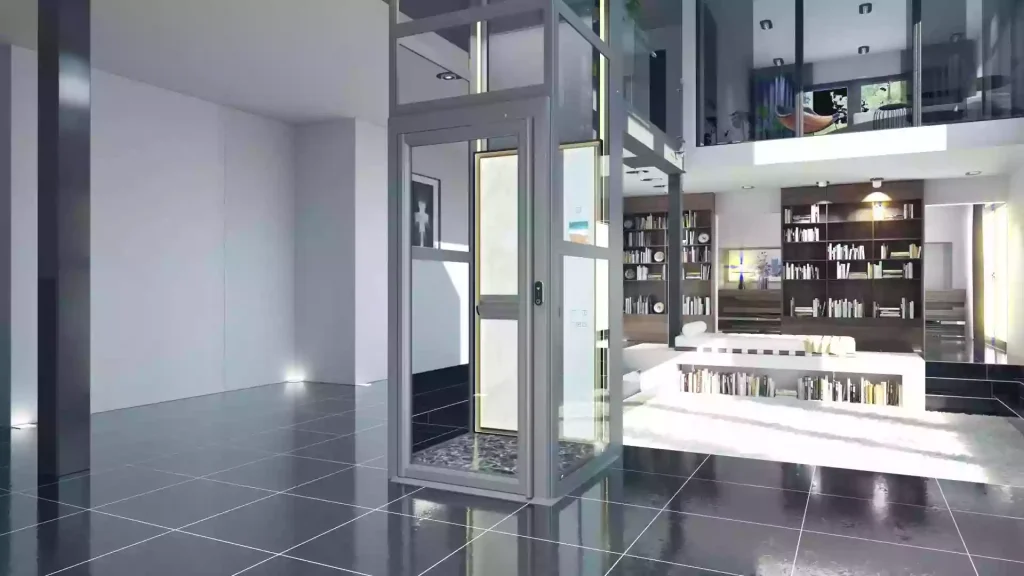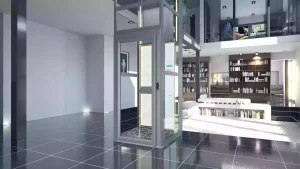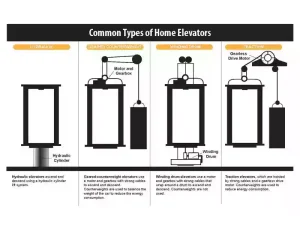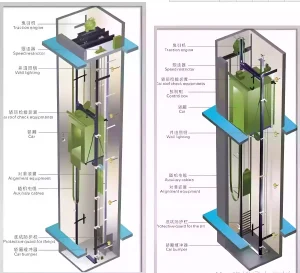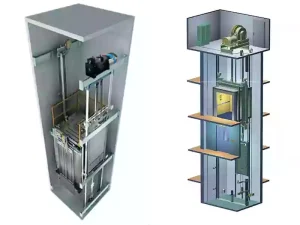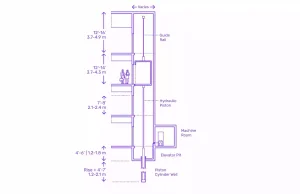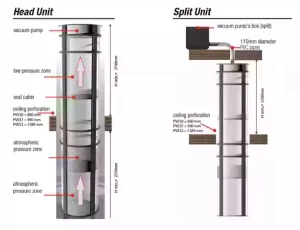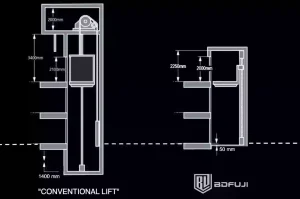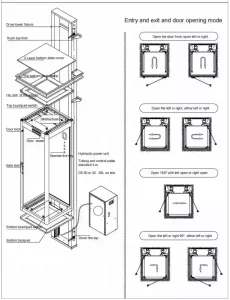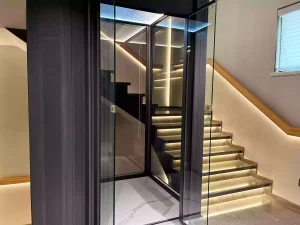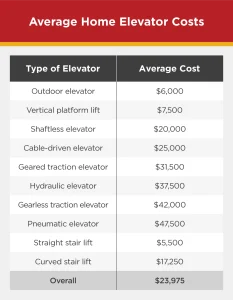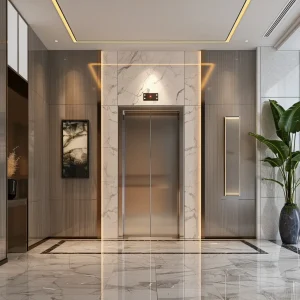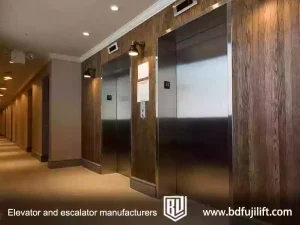The time has come: you’re building or updating your home. If you’re thinking about adding a residential elevator, this guide is for you.
A residential elevator can make your life more convenient, improve access between floors, and even increase your home’s value. It’s especially useful for multi-story homes or for families with older people or those who have difficulty using stairs.
Still, choosing the right residential elevator isn’t always easy. There are many types, prices, and features to think about. So, we’ve put together a clear guide to help you understand your options and make the best choice for your home and budget.
What is a residential elevator?
A residential elevator, also known as a home elevator or private elevator, villa elevator, is a lifting system installed inside or outside a private residence for vertical transportation of people (and sometimes goods) between floors. Unlike commercial elevators, residential elevators are compact, beautiful, flexible, and have lower speeds, making them ideal for homes and villas.
Types of Residential Elevators
Not all residential elevators are the same. Each type works differently and comes with its own pros and cons. To help you choose the right one, here’s a simple guide to the most common options.
Traction Elevators
These elevators move using a pulley and counterweight system. They are often used in taller buildings, but some models work well in homes too. Traction elevators are smooth, energy-saving, and dependable. However, they usually cost more to install and maintain.
Machine Room-Less (MRL) Elevators
MRL elevators don’t need a separate machine room, so they save space—perfect for homes with limited room. They run quietly, use less energy, and are easier to maintain. Most MRL residential elevators are great for houses with 2 to 5 floors.
Hydraulic Elevators (Roped Hydro)
Hydraulic elevators use a pump and piston to lift the car. They are a good choice for low-rise homes, usually up to 4 or 5 stories. These elevators are quiet and provide a smooth ride. They also cost less to install, though maintenance might cost more over time.
Vacuum Elevators
Vacuum elevators use air pressure to move the elevator car up and down. They don’t need cables or pulleys and are made with a clear, tube-like design. These elevators are space-saving, easy to install, and perfect for small homes. However, they may carry fewer people and cost more per trip.
Pitless Elevators
Pitless residential elevators don’t need a deep hole (or “pit”) under the elevator. This makes them a good choice for homes where digging is hard or not allowed. They are simple to install and safer in flood-prone areas. However, they may ride slightly less smoothly than elevators with a full pit.
Shaftless Elevators
Shaftless elevators are made for short travel between two levels. They don’t need a full elevator shaft and take up very little space. These residential elevators are ideal for townhouses or homes with just two floors. They’re affordable and easy to fit into existing homes, but they’re not suitable for taller buildings.
Overview of Residential Elevator Types (Quick Comparison)
|
Types |
Hydraulic Elevator | Traction Elevator | Vacuum Elevator | Shaftless Elevator | Pitless Elevator | MRL Elevator |
|---|---|---|---|---|---|---|
| Drive Mechanism | Hydraulic system | Steel rope + counterweight | Pneumatic (air pressure) | Built-in track system | Motor-driven system | Motor integrated in shaft |
| Suitable Floors | 2–6 floors | Multi-story homes | 2–4 floors | 2–3 floors | 2–3 floors | Multi-story homes |
| Space Requirement | Medium | Medium | Very low | Minimal | No pit required | No machine room needed |
| Cost | Medium | Medium–High | High | Medium | Medium | Medium |
| Recommended Scenarios | Detached villas | High-rise homes / Small apartments | Modern interior homes | Renovations / Compact floor plans | Wooden structures / Old house upgrades | Space-saving architectural designs |
What You Should Know Before Installing a Residential Elevator
Before installing a residential elevator, there are some important things to keep in mind:
Space Requirements
Make sure you have enough space for the elevator. Hydraulic elevators need room for a machine room. MRL elevators need less space, but you still need a shaft and electrical supply.
Noise Considerations
Some elevators can be loud. If noise is a problem, MRL elevators are usually quieter than hydraulic ones. Look for elevators with features that help reduce noise.
Long-Term Maintenance
Think about how easy the elevator will be to maintain. MRL elevators are easier to maintain than hydraulic elevators, which need more frequent repairs.
How to Choose the Right Residential Elevator
Now that you know about the different types of residential elevators, how do you choose the best one for your home? Here are some things to think about:
Consider Your Home’s Layout
If your home has 2 to 5 floors, a hydraulic elevator is a great option. It is relatively inexpensive and requires less space compared to other types. Yet, due to its structure, hydraulic elevators cannot support taller buildings. For homes with more than 5 floors, an MRL (Machine Room-Less) elevator is usually a better fit. It saves space and can support taller buildings, making it ideal for multi-story homes.
Think About Noise
If you want a quieter ride, MRL elevators are usually a better choice. They are quieter than hydraulic elevators, which can be a little louder but still smooth.
Factor in Long-Term Maintenance
Consider how much you’re willing to spend on maintenance. MRL elevators are easier and cheaper to maintain over time compared to hydraulic elevators, which might need more frequent repairs.
Set a Budget
Know how much you’re willing to spend. Residential elevators can range from $20,000 to $60,000 for installation, depending on the type and complexity. Maintenance costs can range from $200 to $500 per year. A residential elevator is a big investment, but it can make your home more convenient and accessible for the long term.
Elevator Brands and Supplier Selection
Recommended Brands
When choosing a residential elevator, it’s important to pick a reliable brand. Some well-known brands for hydraulic elevators are Motion 2000 and TK. These brands are trusted for their smooth and quiet operation, making them a good choice for homes. For higher-quality elevators that offer better performance and reliability, consider BDFUJI or Garaventa. Both of these brands are known for making durable, energy-efficient elevators, and they are especially good for homes with multiple floors.
Choosing the Right Supplier
Choosing the right supplier is just as important as picking the right elevator brand. Here’s what you should think about when choosing a supplier:
-
Experience and Reputation: Look for a supplier that has been in business for a while and has a good reputation. A supplier with experience is more likely to give you high-quality service. Check online reviews and ask for references from past customers to see how happy they were with the company.
-
After-Sales Service: The job isn’t done after the elevator is installed. It’s important to find a supplier that offers ongoing support, such as maintenance and repair services. Make sure they have a plan for keeping your residential elevator running smoothly in the future.
-
Personalized Advice: A good supplier will listen to your needs and help you choose the right elevator for your home. They should offer advice based on your home’s size, layout, and budget. Also, look for suppliers that provide customization options, so you can choose the design and features that work best for you.
-
Installation Process: Ask about the installation process. Make sure the supplier has experienced technicians who can install the elevator properly. A poor installation can cause problems down the road, so it’s important to choose a supplier known for doing the job right the first time. Also, check if they handle permits and inspections.
-
Long-Term Support: Think about the long-term relationship with your supplier. A reliable supplier will be there to help even after the installation. They should be available for repairs, upgrades, or any changes you need in the future.
By carefully considering these factors, you’ll be able to choose a supplier who meets your needs and provides excellent service, making sure your residential elevator is a valuable addition to your home.
Residential Elevator Costs
When you’re planning to add a residential elevator, it’s important to think about both the installation and maintenance costs. Here’s a breakdown of what you can expect:
Residential Elevator Installation Costs
The cost to install a residential elevator varies based on the type of elevator, the number of floors, and how complex the installation is. On average, basic models can cost anywhere from $20,000 to $60,000. If you choose a custom design or add special features, the price can go up even higher.
Residential Elevator Maintenance Costs
Like any household appliance, elevators need regular care to keep them running smoothly. Depending on the type, maintenance costs typically range from $200 to $500 per year. Hydraulic elevators may need more frequent attention because of their fluid systems and moving parts. In contrast, MRL elevators usually require less maintenance, saving you money in the long run.
To learn more, see this article:Elevator Prices 2025: Home Elevator Cost Breakdown
How to Save on Residential Elevator Installation Costs
Installing a residential elevator can be a big investment, but there are ways to keep costs down. Here are some tips to help you save money:
Plan Ahead
The sooner you plan for the elevator in your home’s design, the easier and cheaper the installation will be. Early planning can avoid costly changes to the structure later.
Choose the Right Type
Picking a simpler type of elevator, like an MRL or hydraulic elevator, can cost less than choosing a more complex traction elevator. Choose what fits your needs and budget.
Get Multiple Quotes
Don’t settle for the first price you’re given. Always compare quotes from different suppliers and contractors to make sure you get the best deal.
Conclusion
Residential elevators can not only bring you long-term convenience, but also increase the potential value of your house. Through this guide to residential elevator types, we have learned about the advantages and disadvantages, specifications and popular home elevator brands of different types of residential elevators, and we believe that you can find the residential elevator that best suits your family.
The time has come: you’re building or updating your home. If you’re thinking about adding a residential elevator, this guide is for you.
A residential elevator can make your life more convenient, improve access between floors, and even increase your home’s value. It’s especially useful for multi-story homes or for families with older people or those who have difficulty using stairs.
Still, choosing the right residential elevator isn’t always easy. There are many types, prices, and features to think about. So, we’ve put together a clear guide to help you understand your options and make the best choice for your home and budget.
What is a residential elevator?
A residential elevator, also known as a home elevator or private elevator, villa elevator, is a lifting system installed inside or outside a private house for vertical transportation of people (and sometimes goods) between floors. Unlike commercial elevators, residential elevators are compact, beautiful, flexible, and have lower speeds, making them ideal for homes and villas.
Overview of Residential Elevator Types (Quick Comparison)
|
Types |
Hydraulic Elevator | Traction Elevator | Vacuum Elevator | Shaftless Elevator | Pitless Elevator | MRL Elevator |
|---|---|---|---|---|---|---|
| Drive Mechanism | Hydraulic system | Steel rope + counterweight | Pneumatic (air pressure) | Built-in track system | Motor-driven system | Motor integrated in shaft |
| Suitable Floors | 2–6 floors | Multi-story homes | 2–4 floors | 2–3 floors | 2–3 floors | Multi-story homes |
| Space Requirement | Medium | Medium | Very low | Minimal | No pit required | No machine room needed |
| Cost | Medium | Medium–High | High | Medium | Medium | Medium |
| Recommended Scenarios | Detached villas | High-rise homes / Small apartments | Modern interior homes | Renovations / Compact floor plans | Wooden structures / Old house upgrades | Space-saving architectural designs |
Types of Residential Elevators
Not all residential elevators are the same. Each type works differently and comes with its own pros and cons. To help you choose the right one, here’s a simple guide to the most common options.
Traction Elevators
These elevators move using a pulley and counterweight system. They are often used in taller buildings, but some models work well in homes too. Traction elevators are smooth, energy-saving, and dependable. But, they usually cost more to install and maintain.
Machine Room-Less (MRL) Elevators
MRL elevators don’t need a separate machine room, so they save space—perfect for homes with limited room. They run quietly, use less energy, and are easier to maintain. Most MRL residential elevators are great for houses with 2 to 5 floors.
Hydraulic Elevators (Roped Hydro)
Hydraulic elevators use a pump and piston to lift the car. They are a good choice for low-rise homes, usually up to 4 or 5 stories. These elevators are quiet and provide a smooth ride. They also cost less to install, though maintenance might cost more over time.
Vacuum Elevators
Vacuum elevators use air pressure to move the elevator car up and down. They don’t need cables or pulleys and are made with a clear, tube-like design. These elevators are space-saving, easy to install, and perfect for small homes. Yet, they may carry fewer people and cost more per trip.
Pitless Elevators
Pitless residential elevators don’t need a deep hole (or “pit”) under the elevator. This makes them a good choice for homes where digging is hard or not allowed. They are simple to install and safer in flood-prone areas. But, they may ride slightly less smoothly than elevators with a full pit.
Shaftless Elevators
Shaftless elevators are made for short travel between two levels. They don’t need a full elevator shaft and take up very little space. These residential elevators are ideal for townhouses or homes with just two floors. They’re affordable and easy to fit into existing homes, but they’re not suitable for taller buildings.
How to Choose the Right Residential Elevator
Now that you know about the different types of residential elevators, how do you pick the one that’s best for your home? Here are some important things to consider:
Consider Your Home’s Layout
A 2-story home might not need a big, expensive elevator. But for homes with more floors, an MRL or hydraulic elevator could be a better fit.
Think About Noise
If you prefer a quiet ride, MRL elevators are a great choice. Hydraulic elevators are smooth but might be a little louder.
Factor in Long-Term Maintenance
Think about how much you’re willing to spend on maintenance. MRL elevators tend to cost less to maintain over time.
Set a Budget
Know how much you can spend. Installing a residential elevator can be a big investment, but it can also make your home more convenient and accessible.
Elevator Brands and Supplier Selection
Recommended Brands
When choosing a residential elevator, it’s important to pick a reliable brand. Some well-known brands for hydraulic elevators are Motion 2000 and TK. These brands are trusted for their smooth and quiet operation, making them a good choice for homes. For higher-quality elevators that offer better performance and reliability, consider BDFUJI or Garaventa. Both of these brands are known for making durable, energy-efficient elevators, and they are especially good for homes with many floors.
Choosing the Right Supplier
Choosing the right supplier is just as important as picking the right elevator brand. Here’s what you should think about when choosing a supplier:
-
Experience and Reputation: Look for a supplier that has been in business for a while and has a good reputation. A supplier with experience is more likely to give you high-quality service. Check online reviews and ask for references from past customers to see how happy they were with the company.
-
After-Sales Service: The job isn’t done after the elevator is installed. It’s important to find a supplier that offers ongoing support, such as maintenance and repair services. Make sure they have a plan for keeping your residential elevator running smoothly in the future.
-
Personalized Advice: A good supplier will listen to your needs and help you choose the right elevator for your home. They should offer advice based on your home’s size, layout, and budget. Also, look for suppliers that provide customization options, so you can choose the design and features that work best for you.
-
Installation Process: Ask about the installation process. Make sure the supplier has experienced technicians who can install the elevator properly. A poor installation can cause problems down the road, so it’s important to choose a supplier known for doing the job right the first time. Also, check if they handle permits and inspections.
-
Long-Term Support: Think about the long-term relationship with your supplier. A reliable supplier will be there to help even after the installation. They should be available for repairs, upgrades, or any changes you need in the future.
By carefully considering these factors, you’ll be able to choose a supplier who meets your needs and provides excellent service, making sure your residential elevator is a valuable addition to your home.
What You Should Know Before Installing a Residential Elevator
Before installing a residential elevator, there are some important things to keep in mind:
Space Requirements
Make sure you have enough space for the elevator. Hydraulic elevators need room for a machine room. MRL elevators need less space, but you still need a shaft and electrical supply.
Noise Considerations
Some elevators can be loud. If noise is a problem, MRL elevators are usually quieter than hydraulic ones. Look for elevators with features that help reduce noise.
Long-Term Maintenance
Think about how easy the elevator will be to maintain. MRL elevators are easier to maintain than hydraulic elevators, which need more frequent repairs.
Residential Elevator Costs
When you’re planning to add a residential elevator, it’s important to think about both the installation and maintenance costs. Here’s a breakdown of what you can expect:
Residential Elevator Installation Costs
The cost to install a residential elevator varies based on the type of elevator, the number of floors, and how complex the installation is. On average, basic models can cost anywhere from $20,000 to $60,000. If you choose a custom design or add special features, the price can go up even higher.
Residential Elevator Maintenance Costs
Like any household appliance, elevators need regular care to keep them running smoothly. Depending on the type, maintenance costs typically range from $200 to $500 per year. Hydraulic elevators may need more frequent attention because of their fluid systems and moving parts. In contrast, MRL elevators usually need less maintenance, saving you money in the long run.
To learn more, see this article:Elevator Prices 2025: Home Elevator Cost Breakdown
How to Save on Residential Elevator Installation Costs
Installing a residential elevator can be a big investment, but there are ways to keep costs down. Here are some tips to help you save money:
Plan Ahead
The sooner you plan for the elevator in your home’s design, the easier and cheaper the installation will be. Early planning can avoid costly changes to the structure later.
Choose the Right Type
Picking a simpler type of elevator, like an MRL or hydraulic elevator, can cost less than choosing a more complex traction elevator. Choose what fits your needs and budget.
Get Many Quotes
Don’t settle for the first price you’re given. Always compare quotes from different suppliers and contractors to make sure you get the best deal.
Conclusion
Residential elevators can not only bring you long-term convenience, but also increase the potential value of your house. Through this guide to residential elevator types, we have learned about the advantages and disadvantages, specifications and popular home elevator brands of different types of residential elevators, and we believe that you can find the residential elevator that best suits your family.
Residential Elevator FAQ
Which elevator type is best for residential use?
For most homes, MRL (Machine Room-Less) or hydraulic elevators are ideal. MRL elevators are best suited for mid-rise homes, while hydraulic elevators are a great choice for shorter buildings.
How much space do home elevators require?
Hoistway elevators typically require a width of approximately 4-5 feet (1.2-1.6 meters) and a pit depth of 8-12 inches (20-30 cm). Shaftless and vacuum elevators require significantly less space.
Can I install a home elevator in an existing home?
Yes, you can. Shaftless, vacuum, and hydraulic elevators are particularly suitable for home remodeling projects.
Which residential elevator type is the quietest?
MRL elevators are typically the quietest option, followed by hydraulic elevators. Traction elevators tend to be noisier due to their design.


